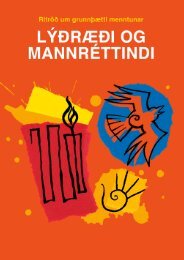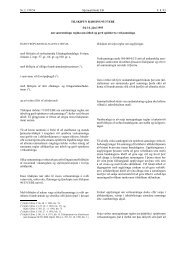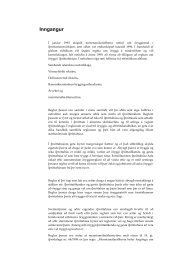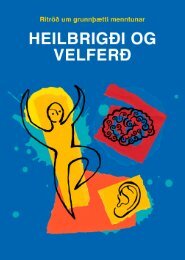Arts and Cultural Education in Iceland : Professor Anne Bamford
Arts and Cultural Education in Iceland : Professor Anne Bamford
Arts and Cultural Education in Iceland : Professor Anne Bamford
You also want an ePaper? Increase the reach of your titles
YUMPU automatically turns print PDFs into web optimized ePapers that Google loves.
Vignette 5.2.4 Our selection process might be tough<br />
This is an <strong>in</strong>dependent <strong>in</strong>stitution under contract to the government. The process is very selective. Around one <strong>in</strong> five<br />
of the valid applications get <strong>in</strong>to a course. There are government quotas. For example, there are only 10 places <strong>in</strong><br />
theatre every year. The academy argues “there is not much more talent than that each year”. They further add, “Our<br />
selection process might be tough but 97% of students compete with<strong>in</strong> the 4 years”.<br />
The <strong>Arts</strong> Academy has cooperation with the 2 universities <strong>in</strong> Icel<strong>and</strong> <strong>in</strong> relation to art history, art theory, bus<strong>in</strong>ess <strong>and</strong><br />
market<strong>in</strong>g. There is no cooperation <strong>in</strong> relation to education or arts education. The <strong>in</strong>stitution is grow<strong>in</strong>g its research<br />
culture, but at the moment does not have any research degree students. They contend <strong>in</strong> relation to arts education<br />
that they focus on discipl<strong>in</strong>e methods <strong>and</strong> hope to produce “terrorists <strong>in</strong> the school system”.<br />
They acknowledge that there is a grow<strong>in</strong>g dem<strong>and</strong> for a broader vision of arts education. In response to what they<br />
perceive as be<strong>in</strong>g a need for better quality, they are <strong>in</strong>troduc<strong>in</strong>g a Masters programme: “The most urgent th<strong>in</strong>g is<br />
better qualifications for teachers <strong>and</strong> cont<strong>in</strong>u<strong>in</strong>g education. Teachers need better ground<strong>in</strong>g <strong>in</strong> the art form before<br />
they can teach it. Generally the teachers <strong>in</strong> the compulsory school have not had enough tra<strong>in</strong><strong>in</strong>g <strong>in</strong> their<br />
discipl<strong>in</strong>e…We are develop<strong>in</strong>g a Masters level course for leaders <strong>and</strong> entrepreneurs work<strong>in</strong>g <strong>in</strong> arts <strong>and</strong> culture. We<br />
need good leaders <strong>in</strong> the field <strong>and</strong> best practice models. You might say we want to tra<strong>in</strong> the super teachers. We have<br />
a strong desire to strengthen leadership.”<br />
Certa<strong>in</strong> groups seem to be particularly effected by a shortage of suitably qualified teachers.<br />
For example, there was a lack of special education tra<strong>in</strong>ed music teachers: “There is a serious<br />
lack of teachers tra<strong>in</strong>ed to teach special education pupils. Most music schools will not accept<br />
these children. We could easily fill at least 150 spaces per year, <strong>and</strong> that is only <strong>in</strong> this area.”<br />
Teacher recruitment <strong>in</strong> rural <strong>and</strong> isolated areas was also perceived to be particularly difficult:<br />
“<strong>Arts</strong> <strong>and</strong> cultural education teachers <strong>in</strong> Icel<strong>and</strong>ic schools are generally well qualified <strong>and</strong><br />
professional. The exception to this is the lack of tra<strong>in</strong>ed arts teachers <strong>in</strong> more isolated rural <strong>and</strong><br />
regional locations. This is particularly the case for woodcraft <strong>and</strong> music teachers work<strong>in</strong>g with<strong>in</strong><br />
the compulsory school environment.”<br />
The tra<strong>in</strong><strong>in</strong>g of teachers appears to be a contentious issue with<strong>in</strong> Icel<strong>and</strong>. Most people<br />
<strong>in</strong>terviewed had strong op<strong>in</strong>ions on teacher education <strong>and</strong> saw the research as an opportunity<br />
to reflect on the current state of teacher education. A similarly open attitude to revision <strong>and</strong><br />
review of the current situation was displayed by some of the key providers of teacher education<br />
as the follow<strong>in</strong>g vignette <strong>in</strong>dicates:<br />
Vignette 5.2.5 This is a contentious area of <strong>in</strong>vestigation<br />
This is a contentious area of <strong>in</strong>vestigation <strong>in</strong> Icel<strong>and</strong>. Compulsory school teachers require an education diploma. This is<br />
currently under revision, but is currently made up of 50% field work <strong>and</strong> 50% free choice of didactic courses. There is<br />
no compulsory arts <strong>and</strong> cultural education for compulsory school teachers <strong>and</strong> comments from teacher education<br />
staff <strong>in</strong>dicate that the majority of early childhood teachers have some compulsory arts education but it appears that<br />
arts <strong>and</strong> cultural education for the compulsory school teacher would depend on their level of <strong>in</strong>terest <strong>and</strong> thus<br />
elective chosen.<br />
For example, <strong>in</strong> early years a typical pattern might <strong>in</strong>clude 2 courses <strong>in</strong> visual arts, 4 units <strong>in</strong> music <strong>and</strong> 2 units <strong>in</strong> both<br />
textile <strong>and</strong> drama for all students. Conversely, only small number of compulsory school teach<strong>in</strong>g students (generally<br />
less than 10%) choose the arts based electives. For example, only around 8-10 students graduate as tra<strong>in</strong>ed wood <strong>and</strong><br />
metal work teachers despite a shortage of teachers <strong>in</strong> this field. For example, a school told me “We do not have a<br />
tra<strong>in</strong>ed woodcraft teacher. We have not been able to get one for two years. We have someone who comes <strong>in</strong> from<br />
the local community.” Actually, this school is lucky compared to others. “The untra<strong>in</strong>ed staff we have all been here for<br />
several years <strong>and</strong> they are good”<br />
In the major teacher education provider <strong>in</strong> the country, selection of the arts specialisation is much lower than most<br />
areas (for example, home economics is more popular than the arts). If students choose arts electives or to ‘major’ <strong>in</strong><br />
the arts, it is possible that up to 1/3 or even more of their course could be <strong>in</strong> the arts. Even then, this is all discipl<strong>in</strong>ebased<br />
tra<strong>in</strong><strong>in</strong>g with a lack of general education <strong>in</strong> creative <strong>and</strong> cultural education <strong>and</strong> the ways <strong>in</strong> which arts-based<br />
pedagogies can improve overall school performance.<br />
107



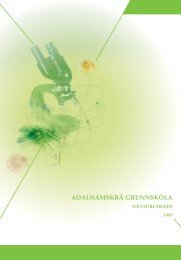
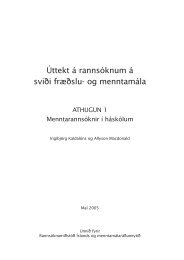

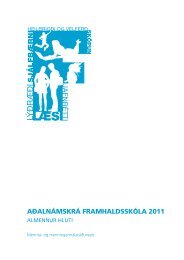
![Aðalnámskrá tónlistarskóla : rytmÃsk tónlist [Eingöngu á rafrænu formi]](https://img.yumpu.com/50843672/1/184x260/aaalnamskra-tanlistarskala-rytma-sk-tanlist-eingangu-a-rafranu-formi.jpg?quality=85)
